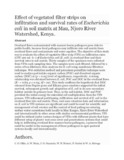| dc.contributor.author | Olilo, C. O. | |
| dc.contributor.author | Muia, A. W. | |
| dc.contributor.author | Onyando, J. O. | |
| dc.contributor.author | Moturi, W. N. | |
| dc.contributor.author | Ombui, P. | |
| dc.contributor.author | Shivoga, W. A. | |
| dc.date.accessioned | 2021-07-09T10:30:16Z | |
| dc.date.available | 2021-07-09T10:30:16Z | |
| dc.date.issued | 2016-12-27 | |
| dc.identifier.uri | https://doi.org/10.1007/s40974-016-0049-0 | |
| dc.identifier.uri | https://link.springer.com/article/10.1007/s40974-016-0049-0 | |
| dc.identifier.uri | http://r-library.mmust.ac.ke/123456789/1768 | |
| dc.description.abstract | Overland flows contaminated with manure borne pathogens pose risks to public health, because fecal pathogens may infiltrate into soil matrix from overland flows and contaminate soil water aquifers. The objective of this study was to evaluate the effect of vegetative filter strip (VFS) on infiltration rates (CFU 100 ml−1 h−1) of Escherichia coli (E. coli) in overland flow and their survival rates in soil matrix. Thirty samples of the specimen were collected from VFSs each sampling time. The samples were each filtered, followed by a series of ten dilutions; then analyses for E. coli using membrane filtration technique. Wet oxidation method and potassium persulfate technique were used to analyze particulate organic carbon (POC) and dissolved organic carbon (DOC) at (p < 0.05) level of significance, respectively. A strong relationship was obtained between E. coli, POC and DOC in the overland flows (R 2 = 0.89, p ≤ 0.05; df = 29). This study confirms the hypothesis that DOC released from Napier grass and Kikuyu grass exudates supported the initial survival, subsequent growth and adaptation of E. coli in its new secondary habitat outside its primary host. Thus, in the soil habitat, DOC and POC provided the initial energy for microbial cell multiplication from the VFS grasses. VFS influenced partitioning, infiltration and survival of E. coli in the overland flow into soil matrix. Thus, root zone retention data and information on E. coli in VFS systems are significant and could be used for scientific and management of soil erosion and the control of fecal pathogens entering surface water ecosystems both locally in Mau Ranges, Njoro River Watershed and internationally in other areas with similar environmental problems. VFS could be utilized under various designs of VFSs with different plants that have different setup of plants’ root zone cover and penetrations systems that could help in infiltrating overland flow manure borne pathogens, a process that could be useful in the management of these pathogens in agro-pastoral systems locally and internationally. | en_US |
| dc.language.iso | en | en_US |
| dc.publisher | Energy, Ecology and Environment | en_US |
| dc.subject | Effect, vegetated, filter, strips, infiltration, survival, rates, Escherichia, coli, soil, matrix, Mau, River Watershed | en_US |
| dc.title | Effect of vegetated filter strips on infiltration and survival rates of Escherichia coli in soil matrix at Mau, Njoro River Watershed, Kenya. | en_US |
| dc.type | Article | en_US |

